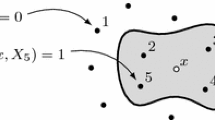Abstract
The design of distributed autonomous systems often omits consideration of the underlying network dynamics. Recent works in multi-agent systems and swarm robotics alike have highlighted the impact that the interactions between agents have on the collective behaviours exhibited by the system. In this paper, we seek to highlight the role that the underlying interaction network plays in determining the performance of the collective behaviour of a system, comparing its impact with that of the physical network. We contextualise this by defining a collective learning problem in which agents must reach a consensus about their environment in the presence of noisy information. We show that the physical connectivity of the agents plays a less important role than when an interaction network of limited connectivity is imposed on the system to constrain agent communication. Constraining agent interactions in this way drastically improves the performance of the system in a collective learning context. Additionally, we provide further evidence for the idea that ‘less is more’ when it comes to propagating information in distributed autonomous systems for the purpose of collective learning.
Access this chapter
Tax calculation will be finalised at checkout
Purchases are for personal use only
Similar content being viewed by others
Notes
- 1.
We found that 20 agents were sufficient to complete the task with performance similar to that of 50 agents.
References
Bechon, P., Slotine, J.J.: Synchronization and quorum sensing in a swarm of humanoid robots. arXiv preprint arXiv:1205.2952 (2012)
Brambilla, M., Ferrante, E., Birattari, M., Dorigo, M.: Swarm robotics: a review from the swarm engineering perspective. Swarm Intell. 7(1), 1–41 (2013)
Crosscombe, M., Lawry, J.: A model of multi-agent consensus for vague and uncertain beliefs. Adapt. Behav. 24(4), 249–260 (2016)
Crosscombe, M., Lawry, J.: Collective preference learning in the best-of-n problem. Swarm Intell. 15(1), 145–170 (2021)
Crosscombe, M., Lawry, J.: The impact of network connectivity on collective learning. In: Matsuno, F., Azuma, S., Yamamoto, M. (eds.) DARS 2021. SPAR, vol. 22, pp. 82–94. Springer, Cham (2022). https://doi.org/10.1007/978-3-030-92790-5_7
Douven, I.: Optimizing group learning: an evolutionary computing approach. Artif. Intell. 275, 235–251 (2019)
Douven, I., Kelp, C.: Truth approximation, social epistemology, and opinion dynamics. Erkenntnis 75(2), 271–283 (2011)
Franks, N.R., Richardson, T.: Teaching in tandem-running ants. Nature 439(7073), 153–153 (2006)
Hamann, H.: Superlinear scalability in parallel computing and multi-robot systems: shared resources, collaboration, and network topology. In: Berekovic, M., Buchty, R., Hamann, H., Koch, D., Pionteck, T. (eds.) ARCS 2018. LNCS, vol. 10793, pp. 31–42. Springer, Cham (2018). https://doi.org/10.1007/978-3-319-77610-1_3
Heyes, C.M.: Social learning in animals: categories and mechanisms. Biol. Rev. 69(2), 207–231 (1994)
Hogg, E., Harvey, D., Hauert, S., Richards, A.: Evolving robust supervisors for robot swarms in uncertain complex environments. In: Matsuno, F., Azuma, S., Yamamoto, M. (eds.) DARS 2021. SPAR, vol. 22, pp. 120–133. Springer, Cham (2022). https://doi.org/10.1007/978-3-030-92790-5_10
Innocente, M.S., Grasso, P.: Self-organising swarms of firefighting drones: Harnessing the power of collective intelligence in decentralised multi-robot systems. J. Comput. Sci. 34, 80–101 (2019)
Kwa, H.L., Leong Kit, J., Bouffanais, R.: Balancing collective exploration and exploitation in multi-agent and multi-robot systems: a review. Front. Robot. AI 8, 771520 (2022)
Lazer, D., Friedman, A.: The network structure of exploration and exploitation. Adm. Sci. Q. 52(4), 667–694 (2007)
Parker, C.A., Zhang, H.: Cooperative decision-making in decentralized multiple-robot systems: the best-of-n problem. IEEE/ASME Trans. Mechatron. 14(2), 240–251 (2009)
Rubenstein, M., Ahler, C., Hoff, N., Cabrera, A., Nagpal, R.: Kilobot: a low cost robot with scalable operations designed for collective behaviors. Robot. Auton. Syst. 62(7), 966–975 (2014). Reconfigurable Modular Robotics
Schranz, M., Umlauft, M., Sende, M., Elmenreich, W.: Swarm robotic behaviors and current applications. Front. Robot. AI 7, 36 (2020)
Talamali, M.S., Saha, A., Marshall, J.A., Reina, A.: When less is more: robot swarms adapt better to changes with constrained communication. Sci. Robot. 6(56), eabf1416 (2021)
Valentini, G.: Achieving Consensus in Robot Swarms. SCI, vol. 706. Springer, Cham (2017). https://doi.org/10.1007/978-3-319-53609-5
Valentini, G., Ferrante, E., Dorigo, M.: The best-of-n problem in robot swarms: formalization, state of the art, and novel perspectives. Front. Robot. AI 4, 9 (2017)
de Vries, J.: Image processing and noise reduction techniques for thermographic images from large-scale industrial fires. In: Proceedings of the 12th International Conference on Quantitative InfraRed Thermography (QIRT) (2014)
Watts, D., Strogatz, S.: Collective dynamics of ‘small-world’ networks. Nature 393, 440–442 (1998)
Acknowledgements
This work was funded and delivered in partnership between Thales Group, University of Bristol and with the support of the UK Engineering and Physical Sciences Research Council, ref. EP/R004757/1 entitled “Thales-Bristol Partnership in Hybrid Autonomous Systems Engineering (T-B PHASE).”
Author information
Authors and Affiliations
Corresponding author
Editor information
Editors and Affiliations
Rights and permissions
Copyright information
© 2024 The Author(s), under exclusive license to Springer Nature Switzerland AG
About this paper
Cite this paper
Crosscombe, M., Lawry, J. (2024). The Benefits of Interaction Constraints in Distributed Autonomous Systems. In: Bourgeois, J., et al. Distributed Autonomous Robotic Systems. DARS 2022. Springer Proceedings in Advanced Robotics, vol 28. Springer, Cham. https://doi.org/10.1007/978-3-031-51497-5_2
Download citation
DOI: https://doi.org/10.1007/978-3-031-51497-5_2
Published:
Publisher Name: Springer, Cham
Print ISBN: 978-3-031-51496-8
Online ISBN: 978-3-031-51497-5
eBook Packages: Intelligent Technologies and RoboticsIntelligent Technologies and Robotics (R0)




